#butchering
Note
I had an older rooster who started being really aggressive and I had to cull him. Highly recommend slow cooking with oil, a little lemon juice, salt, and some pepper. By slow cooking I mean really low and slow. By the end the meat was falling off the bone. I used the juice to make rice to serve it on. Yummy.
I actually can't really slow cook my serama. They are way to small! They cook really fast and are pretty delicate. Here is a batch of cockerels I culled a long time ago, you can see why I want to cross in breeds to add more meat to these scrawny things. What's nice about these guys though is you get like 2 personal chickens to eat lol 😆 I prefer using the meat in soup though
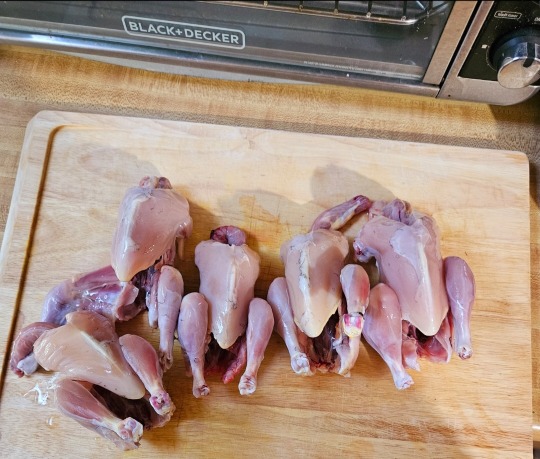
39 notes
·
View notes
Text
The 8 Primal Cuts of Beef — A Beginner’s Guide
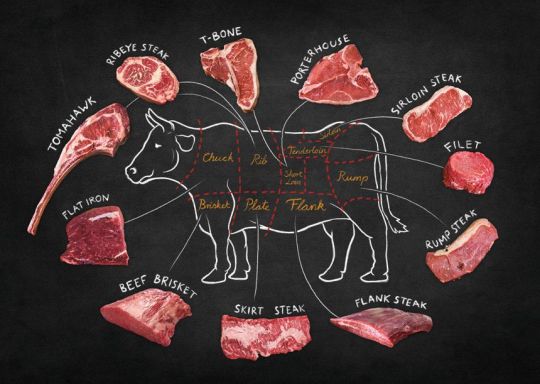
One of the first steps to making smarter choices with beef — whether from your local butcher or other cattle farm, is understanding what cuts come from where on a cow. This helps you understand typical fat content, uses, and get an idea of why some cuts are pricier than others.
There’s a lot of jargon in beef. From hanger steaks to delmonico steaks, there are a lot of terms to remember. Today, we’re going to start with the fundamental 8 primal cuts you need to know.
These are the 8 parts of the cow (steer) that all American butchers organize their cuts from, and if you’re looking to cut your own steaks, save money on volume, buy in bulk for a large gathering, or buy wholesale for a restaurant, this is your first step to understanding the steer.
The 8 primal cuts of beef:
• Chuck
• Rib
• Loin
• Round
• Flank
• Plate
• Brisket
• Shank
Within each of the 8 primal cuts are what are known as “sub-primal cuts”. These are just specific names for large parts within each primal cut. Within each sub-primal cut are the “portion cuts”, which are the consumer-facing portions you see in stores.
We’ll cover what each primal cut is and include some of the sub-primal and portion cuts found within each primal. We’ll also provide rough weights and percentages based on a 1,300-pound steer [*].
1. Chuck
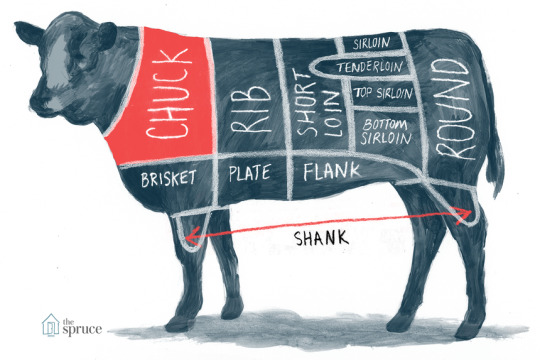
Portion of the cattle carcass: 29%
Average weight after fat and bone loss: 198.4lbs
Chuck is the primal cut that includes the shoulder of the steer and is arguably the most versatile cut. It’s delicious, plentiful, and used in a wide variety of cooking applications.
The chuck primal is rich in meat and marbling, which helps add flavor and tenderize the surrounding meat. Although rich in flavor, chuck cuts are not as tender as the elegant middle steak primals; consequently, they are perfectly suited to pot roasts and braising cooking.
This primal cut is also the most popular source for ground beef, thanks to its rich flavor and its balance of meat and fat. Over half of the chuck is typically harvested for ground beef.
Chuck subprimals
The chuck’s sub-primals are the chuck roll, chuck eye, chuck short ribs, chuck tender, clod top blade, clod heart, and teres major.
Chuck portion cuts
Portion cuts from the chuck primal include ground beef, cubed beef, shoulder center roast, and chuck eye steak.
Chuck can be cooked about any way you like. If you’re using chuck ground beef, fire up the grill and have some burgers. If you go with the shoulder center roast, try braising it since chuck can be a bit tougher than other cuts.
2. Rib

Portion of the cattle carcass: 9%
Average weight after fat and bone loss: 63.2lbs
The rib primal includes the meat cut from the ribs and backbone of the cow. Rib meat has a distinctive, sought-after flavor and is more expensive than many other cuts.
This primal is the source, as you might expect, for ribs. Although there are 13 pairs of ribs, only ribs six through 12 fall into the rib primal. (One through five are part of the chuck cut and the 13th rib is part of the loin.)
Rib subprimals
The rib’s sub-primals are the ribeye roll, peeled cap, beef rib / blade meat, and short ribs.
Rib portion cuts
Portion cuts from the rib primal include the ribeye roast and steak, prime rib, the rib short ribs, the ribeye petite steak, and ribeye filet.
Popular cuts like prime rib, short rib, and ribeye steak do best with high, direct heat and short cooking times, but the back ribs are best suited for indirect cooking methods like smoking.
3. Loin
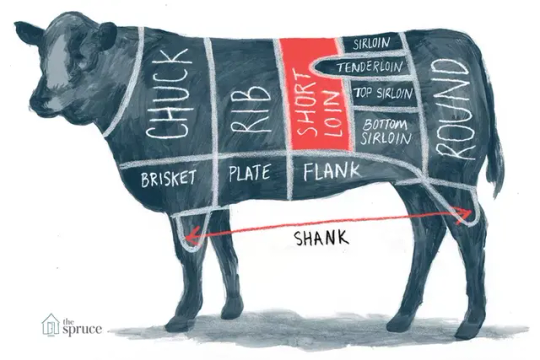
Portion of the cattle carcass: 16%
Average weight after fat and bone loss: 99.5lbs
Because this primal is from some of the least-used muscles of the cow, meat from this cut is particularly tender. As a result, these cuts do not require long cooking times and are often the most expensive.
Loin subprimals
The loin’s sub-primals are the butt tender, peeled tenderloin, strip loin, top butt, ball tip, tri-tip, and bottom sirloin flap. Looking to cut your own steaks? Try our 100% grass-fed whole primal striploin.
Loin portion cuts
Portion cuts from the loin primal include the t-bone steak, filet mignon, delmonico steak, ny strip steak, sirloin roast, porterhouse steak, and tri-tip roast.
Loin cuts take well to open flame and other direct heat methods. Some of the loin cuts are the priciest cuts on the steer, so we recommend cooking them medium-rare to get the most flavor.
4. Round

Portion of the cattle carcass: 22%
Average weight after fat and bone loss: 140.9lbs
The round is cut from the rear of the cow, including the hind shank and the rump. Because the round is so lean and doesn’t have as much marbling, your cooking method will vary depending on the subprimal cut.
You can slice the round into 5/8 inch thick steaks for country fried round steaks. The round can also be separated into sections or seamed out into the Top, Bottom, and Eye of Round. The top can be cut 1 ½-2 inch thick steaks and makes for a fantastic London Broil, and the Bottom Round is often used for corned beef.
Round subprimals
The round’s subprimals are the round tip, top round, bottom round, and rump.
Round portion cuts
Portion cuts from the round primal include the bottom round steak, eye of round steak, top round roast, and round tip steak.
Meat from the round tends to be very lean and not as tender — making it best suited for moist cooking. There are exceptions to this: London broil is delicious when grilled, and sirloin tip and sirloin sandwich steaks are light, healthy meats that require minimum preparation times.
Any of the round items makes for a wonderful beef roast, too. Just remember to serve it medium and slice it thin. If you’re a jerky fan, any of the round pieces make great jerky, too. Just remove all fat and silver skin before drying it.
5. Flank

Portion of the cattle carcass: <1%
Average weight after fat and bone loss: 4.6lbs
The flank is the primal cut just below the loin primal, so it is the “bottom most” primal excluding the little bit of meat you can collect from the shank (legs) of the cow. Flank has been historically cheap but with lean meat on the rise, flank has inflated in price.
Flank subprimals
The flank’s subprimals are just the flank.
Flank portion cuts
Portion cuts from the rib primal are just the flank steak and any ground beef the butcher collects.
This cut requires a bit of love and attention, but it can be worth it. It’s wonderful baked, and make sure you give it a good marinade to tenderize the meat.
6. Plate
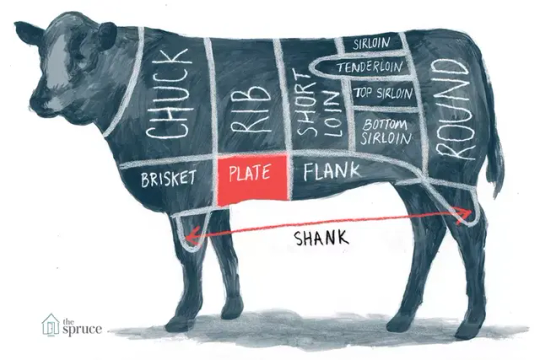
Portion of the cattle carcass: <2%
Average weight after fat and bone loss: 9.2lbs
The plate primal (also called the short plate) is located under the rib primal, close to the stomach of the cow. The cuts from the plate are slightly tough and therefore better prepared with moist cooking methods. It is generally a cheap cut of meat, and a leaner plate can be used for beef bacon. Most butchers use the plate for ground beef, though.
Plate subprimals
The plate’s subprimals and portion cuts are one in the same. Since there isn’t a lot of meat in the plate, it is cut directly into portion cuts or ground into ground beef.
Plate portion cuts
Portion cuts from the plate primal include the hanger steak, short ribs, skirt steak, and beef bacon.
Low and slow is the name of the game with the plate primal. This meat is inexpensive, tough, and takes best to moist cooking methods.
(Jingo's commentary- think of this like brisket but not as thick and more ribby rich flavor. This is one of the primals used to cure beef bacon. Yes I know it says that up there but this is important)
7. Brisket

Portion of the cattle carcass: 11%
Average weight after fat and bone loss: 27.6lbs
The brisket primal is from the front of the animal beneath the chuck primal. It’s essentially the breast meat of the cow. Because cuts from the brisket are among the less tender, they are best suited for moist cooking methods like braising, stewing, and steaming.
Common cuts from the brisket primal include the brisket point and brisket flat. The point is fattier and better suited for pot roast, and the flat is a bit leaner and better for square cuts and corned beef.
Brisket subprimals
The brisket’s subprimals are simply the brisket.
Brisket portion cuts
Portion cuts from the brisket primal include the point cut and flat cut.
Brisket is famously delicious but also known to be tough and sinewy. To combat this and unlock the unique meaty flavor of the brisket, you should stick to moist cooking methods like braising, smoking, steaming, and stewing.
(Jingo's commentary- if it is tough, then you fucked up. Fact statement. There are techniques. Ask me and we will start up a thread and get a bunch of the boys to do a brisket bull session. Second bit, this is one of the primals you can use for beef bacon. Yes...you heard me. Beef bacon. Assume that an angel's choir just fired up)
8. Shank
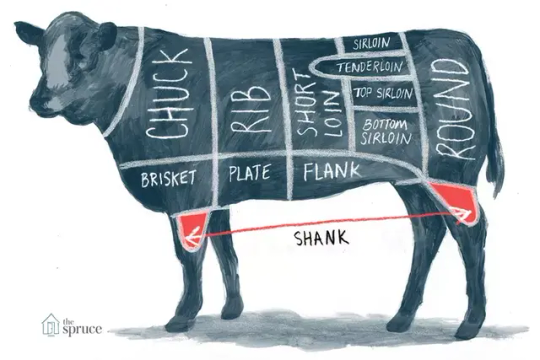
Portion of the cattle carcass: 10%
Average weight after fat and bone loss: 40.3lbs
Meat from the shank primal is some of the toughest; as a result, most stores and retailers do not offer cuts from this primal. If you do get some, it is great for marrow and lean ground beef, but in general, it is so tough and sinewy it’s difficult to get much more out of it. Other miscellaneous pieces that are sometimes harvested include the kidneys.
Shank subprimals
The shank’s subprimals include marrow bones and ground beef.
Shank portion cuts
Apart from the bones and a little bit of beef, most retailers don’t sell shank. Beef kidneys are fairly popular, though.
The best use for a shank is to use them to make beef broth or to cook them low and slow in a dish like osso buco. Because shank has such little fat, you’ll need to cook it for a long time to make it worth it.
(Jingo's commentary on shank, not part of the article - adding shank to almost any crock pot meal, up to and including chili is outstanding. The steak from that area is fine but it is the bone marrow is what you want. The amount of satiety you will get from high amounts of bone marrow in solution in dishes will shock you. Even higher satiety...long term satiety is even better than even the fattiest meal you have ever had. It also helps to act as a binder and a bit of a food glue if that makes sense. If you don't want to buy flank steaks, ask the meat counter guys about cross cut large bones and throw them any slow cooker meal. It is so good, good for you and will help tighten up that loose skin as you loose weight.)
Credit Nathan Phelps
Congratulations on getting to the end. Here is your reward

(There are tonnes of additions I would make and things said in the article I would disagree with but it is a good general guide)
63 notes
·
View notes
Text
Turkey
I got a frozen turkey in November that I've been saving for now, when my aunt and her husband are visiting. I got it out days ago and put it in the fridge to thaw (as one should). I didn't put it in the roasting pan, like an idiot; I know that all thawing meat makes a mess no matter how well it is wrapped. Cue Tuesday, when I find that it had made good progress on thawing (good!) whilst dripping at least a quart of 'fluids' all over the inside of the fridge. It took almost an hour to clean the mess thoroughly, all the while I was kicking myself for not putting it in something to thaw. But honestly, this staggering amount of water loss was not my expectation. I weighed it just now before popping it in the oven, and it had lost over 2 pounds (nearly a kg) of weight compared to the (frozen) weight on the tag. For this medium-sized turkey, that is an unconscionable amount of added water; 13-14% of the original weight. They had to have filled the body cavity with water when packaging it just to bulk up the weigh/price.
It is in the oven. Based on re-weighing it, I know how long it needs to be in there. I'm sure it will be delicious when it's done. Just - jeez! I want to raise my own turkeys again next year. Butchering is a big job - but you know what you're getting.
24 notes
·
View notes
Text
Angel Farm
Note: I spent all day yesterday butchering chickens and naturally had to write angel whump. I promise that real butchering is much more humane than...whatever this pure blasphemy is.
TW: mass murder, eating a sentient species, raised for slaughter, religious whump, gore, referenced death of unborn children, dehumanization, captivity, immortal whumpees, angel whumpees, multiple whumpees, demon whumpers, multiple whumpers
Butchering day had come around once again. Without a doubt the most horrific time of the year.
The butchering stations had all been set up the day before. Sharp knives laid out on cutting boards. Metal buckets beneath the tables to scrape viscera into. Plastic bags to seal the dismembered carcasses in. Same as last year. The old poplar tree stump next to the coop had an ax head buried in its blood stained heart wood.
Less angels had been born this year. The living angels had heard the demons discussing the high demands for eggs. Some were unfertilized, worth nothing to the angels who laid them. Others were left beneath the mothers until the chicks were nearly ready to hatch before being stolen away. A delicacy of the nine rings. The mothers had stopped crying years ago.
Some angels tried to hide behind buckets of feed or under the roost when they heard the demons approaching. It wasn't any use, and they knew it. But still they hid, shielding their bodies with glossy white wings, hoping for mercy from merciless beings. Most of the angels simply milled around, making no effort to hide, or slept through the day until they were selected.
The hope blooming in the heart of every angel, no matter their temperament or outlook, was that the demon desecrating their body would slip with their knife, destroying their heart so they would never regenerate.
To be finally at peace was a dream too outlandish for a reasonable angel, but still it happened every so often. Once or twice every decade. Enough to keep hope alive. But more angels were born than died, new coops being built every year to house them.
They were allowed to watch the butchering process. Peering through the barbed wire fence that kept them from ever spreading their massive wings in flight. Most didn't care for the sickening display. But a macabre few found comfort in memorizing the process.
Some angels, brave and foolish, fought to escape as soon as they were brought out of the coop. Those rare few who managed to fly away were always caught, drunk on glorious freedom. Angels didn't last long in the fire and brimstone of hell.
Demons beheaded angels with mighty axes, seizing their heads by blood slicked white hair and tossing them in a bin to be fed to the hellhounds. The wings of the decapitated angels thrashed against the grasps of demons, overcome with painful muscular spasms.
Some kept this up intentionally, knowing they were worth less with their wings broken. Any frustration caused to their tormentors was well worth the agony of broken bones.
Being thrown in scalding water to loosen their skin in feathers was pure agony, their insides filling with water through their gaping esophagus. The water wasn't even boiling, as that would ruin their meat by cooking them too early. It could even be considered chilly compared to the many hotsprings of hell.
But angels used to staying dry and bathing in dust could hardly bear the sensation of water at any temperature. They hardly noticed the plucking afterward, still in dreadful shock. Their beautiful wings were stripped of their protective feathers, left as bare as any other patch of skin on their too delicate bodies.
The angels were finally recovered from the shock of water in time for horrific disembowelment. Their craws were removed first. Accidentally puncturing them could ruin their meat, so the demons were particularly careful. Their throat was then removed, thrown in a bin to later be made into soup stock. But those were the easy steps.
Next, a piece of their flesh was roughly cut out, stretching from the bottom of their ribcage to their tailbone. Demons reached inside their chest cavity, ripping out intestines and other disgusting organs with horrible glee, seeing if they could remove the digestive tract in one piece.
They left the hearts inside the body out of cruelty while they separated the organs to be bagged and sold. Intestines were cleaned to make sausages. Livers and kidneys were saved to be fried up and eaten. Stomachs and lungs were tossed to the curious cats jumping on the butchering table to lap up pools of blue angel blood.
Then came the dismemberment. Wing, leg, and breast meat was all cut apart with well practiced precision. Still the hearts beat within the chest cavity, only to cause the angels pain through the entire process. Only after the carcass had been dismembered and the chest cavity was thoroughly cleaned out, the hearts were finally removed.
They were kept in incubators, beating without pumping blood, while the angels fully reformed over a course of weeks. The lack of a body was disturbing, but the absence of pain proved beyond relieving. They couldn't really think, but they could perceive. A state of purgatory within the bowels of hell.
And to think they had once been a glorious species, soaring through the skies of heaven and delivering God's messages to the humans below them on earth. Now fallen from grace they were lower than even humans, bred like livestock by cruel demons and treated as nothing more than a source of food.
At least butchering was over for this year.
Taglist: @hugh-lauries-bald-spot @devourerofcheesecake @whumpshaped @whumpsday @heavenly-whumper @kira-the-whump-enthusiast
#Abraham original: Hot off the press#Whump#Angel whump#Religious whump#Butchering#Angels#Demon whump#Angel whumpee#Demon whumper#Multiple whumpees#Multiple whumpers#Dehumanization#Raised for slaughter
59 notes
·
View notes
Text
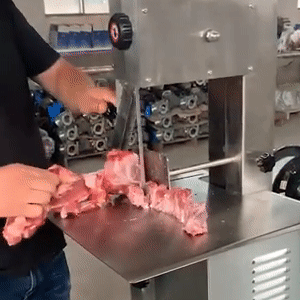

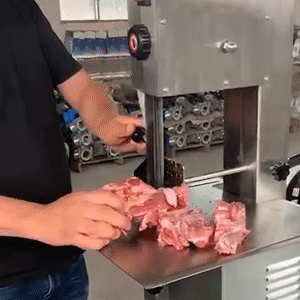
stainless steel bone saw machine | source
#talos gifs#stim gifs#stim#meat#raw meat#butchering#irl hands#mechanical#ask 2 tag#gif ids#id in alt#this gifset isnt the best. this channel has some other more gruesome videos lmk if ye're interested
31 notes
·
View notes
Text
Save Money, Cut Your Own Meat

This is half of an 8.8 pound pork roast from Costco. It cost me $20.22.
Yes, you read that right. Under $3/pound. In 2023, where even breathing the air is expensive.
It’s a whopping big chunk of meat, and Costco pork is decent. (Would I love to be indulging in small-farm meat? Of course. Does the budget permit? Not always.)
Pork loin is incredibly forgiving to a first-time butcher. All you do is cut it straight down, as shown above.
You’ll notice I’ve started cutting it into pork chops. I’d already cut the other half into a mix of chops and larger pieces that I’ll probably cut up smaller later and use for stir-fry or pork jun.
Do you need to be meticulous about your sizing? Nope. You can see where I slashed the fat to indicate roughly a pound of meat (8ish pounds divided in half, then divided by 4). I then divided each pound that I was planning to use for chops in four, and cut those.
I did end up deciding to use the last two pounds as a roast, so there’s a nick in the fat cap on that. Oh well, that’s fine.

Bag up your meat in freezer bags. Choose to store it in sizes that you’ll eat, so if it’s just for one, I’d store it in either half-pound or pound increments — so one meal fresh and one meal of leftovers out of a half-pound. If it’s for two or more, you’ll probably want to start with a pound per bag, and you might want to do two, depending on how many people you’re feeding.
Weigh it up (optional, but I like to know), label and date, squish all the air out, and toss it in your freezer. Voilá, you have meat for months. Even if you eat a pound of pork (four chops) a week, you’ve got two months worth of meat and it cost you only $20-some and a bit of your time.
14 notes
·
View notes
Text
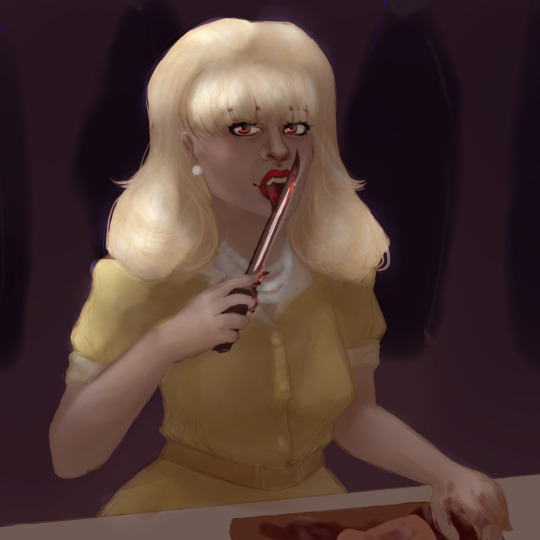
Thanks @mura-128 for letting me butcher your oc until I got it right <3
💚💚💚
#digital art#art#I think I actually spent 3hrs redoing the hands over and over#I did the lighting 3 times#gotta hurry up and post it before I find new issues with it <3#vampire girl#butchering#Ignore the body bags in the background#shes having a snack#while fixing a meal for her friends#drug raccon and feminine wrath embodied#:)
7 notes
·
View notes
Text
a guide to butchering tools..
interested? contact me <3 xoxo

3 notes
·
View notes
Text

🐐
#12 inch blade for reference#Native American culture#if tumblrs really about race diversity this won’t get taken down:)#my culture is not offensive#butchering#homesteading#living off the land#chivo#goat#cabra#buck knives#buck 120#organic#nongmo
16 notes
·
View notes
Note
is there a difference between plucking silked and regular feathers when you're prepping a dinner bird?
I find silked birds easier to pluck but the feathers are super staticy and will go EVERYWHERE. I prefer skinning my birds its just faster and easier, way less clean up.
15 notes
·
View notes
Text

Today, I Am Death
I cover blood with earth,
your blood,
brought visible by my will,
for today, I am death.
All things change
after flesh meets steel,
and our long conversation
comes to a close.
The heat lamp goes out,
the stampede to feasting ends,
my arrivals and departures
now go unnoticed.
The view from pen to plate
an unknowing Eve,
but plate to pen
is like Adam watching
with an open hand.
Today, I am death,
for now I know,
and everything I taste
will never
be the same.
Eric Blauer 11/14/23
3 notes
·
View notes
Text
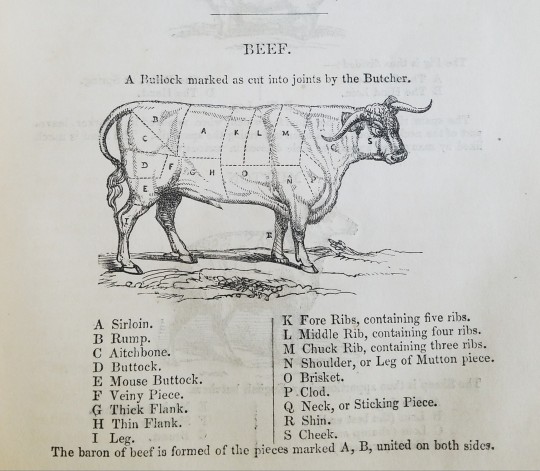


Butchering
-The Illustrated London Cookery Book 1852
5 notes
·
View notes
Text


Good golly that's satisfying! Hes given us so much trouble, keeping other bucks away but never stepping into the open for a good shot. It FINALLY frosted over last night and the bucks came pouring in this morning as they always do on a good frost.

27 notes
·
View notes
Text
butchering/meat photo under the break
it’s not gory or anything but still

had this photo taken for the store-wide announcement that i started the butcher apprenticeship! here i’m prepping a ribeye for dry aging.
this shit is so fun tbh and i’m only gonna continue improvinggggg 😌
#butchering#meat#tw animal bones#idk what tws to tag this with#butchery#are there literally any other butchers/meat cutters on tumblr#or is this an unfilled niche#don’t come at me about dOnT eAt MeAt i’ll just block
3 notes
·
View notes
Text
I hardly follow the witcher news anymore, but I did once, so some things pop up in my social media.
Just saw Jaskier. What the hell did they do to him to make him look so awfully unappealing? I can't even pinpoint what jars me the most, but I know that I rarely get this kind of reaction.
... Then again I did my best to forget scenes with him in season 2 (to forget 90% of season 2).
I hope I will live long enough to actually see a good adaptation of The Witcher.
3 notes
·
View notes
